You have likely heard the siren songs of the surf while visiting California’s vast coastline. The terns squawking and waves crashing, calling you to cast your line in.
As anglers, the presence of water elicits many questions, the most essential being, “I wonder what I can catch in it?” The curious angler is the angler who will excel and eventually master fishing in the surf, as there is much to be curious about. A departure from the predictability of rivers and lakes, where most anglers have honed their skills, the surf requires a deeper understanding of current conditions as they change daily. The cool, misty air, the limitless potential, and the challenge of figuring out an entirely new method of fishing make the surf a worthy pursuit. Fishing from the sand has become an obsession that captivates and perplexes me in the way wading a trout stream did when I first fell in love with fly fishing.
All this said, my first experience in the surf was a miserable failure. I tried to conquer the Pacific Ocean with my steelhead rod mid-day without a stripping basket. It chewed me up and spit me out. One does not conquer the ocean but needs to learn its rhythms and dance with it.
TARGET SPECIES
One of the most unique aspects of fishing the surf is that a fish of a lifetime is a real potential on any given cast. Running into a school of Chinook feeding on surf smelt fuels every 4:30 a.m. wake up. Surf perch are among the most plentiful and year-round species to target in the surf up and down the California coast. Depending on location, most surf anglers graduate from perch to chase striped bass, halibut, or corbina. For Southern California anglers, corbina is the jewel of the beach, feeding in the shallows. They are often sight-fished on a 6 or 7 weight in the summer. At the same time, striped bass captivate anglers wielding 8 and 9 weights from Pajaro to Gualala.
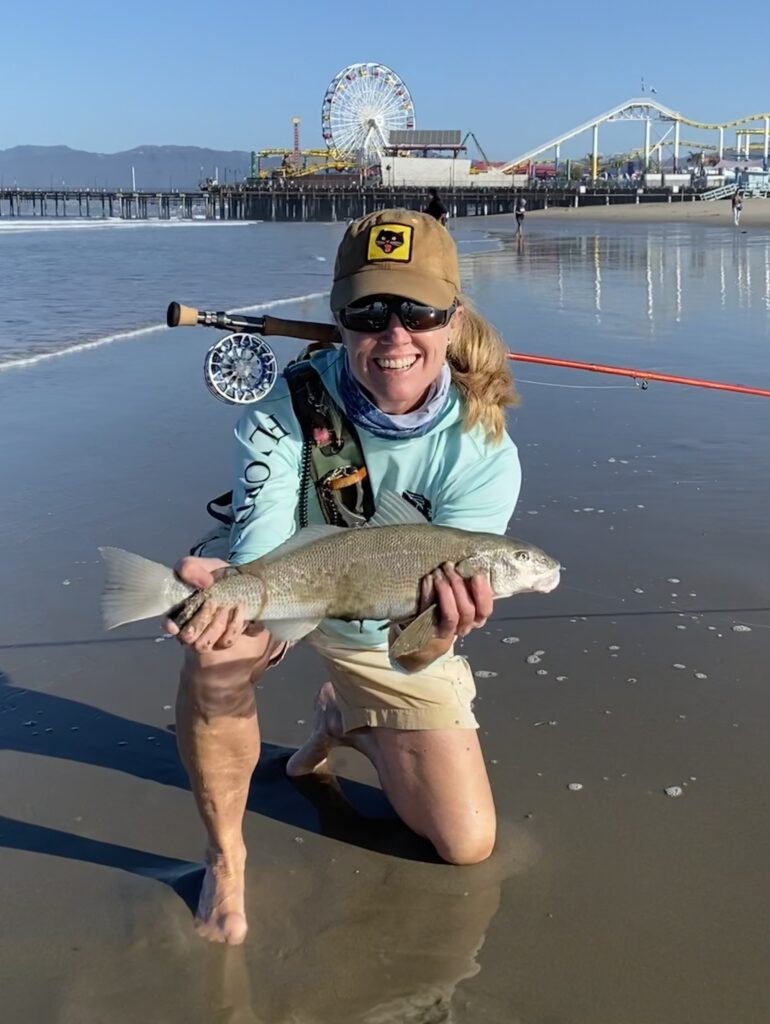
GEAR
Rods
One of the most significant barriers to fishing the surf is that your 9-foot 5 weight has little application. Fly rods for surf fishing typically range from 6-9 weight in single-hand and double-hand configurations. Single-hand rods in nine to 10-foot configurations are ideal. At the same time, two-hand rods in the 11-foot range are best. Longer rods aid in casting over the waves and can increase distance. Two-handed rods lower the barrier to entry by providing distance and line speed without perfecting the double-haul.
Lines
Fly lines are where things start to vary significantly. My fastest-sinking option is my most commonly used surf line, sinking at 7-9 inches per second. The Rio Outbound Short series offers a variety of sink rates for the angler. The Rio Outbound Short features a 30 foot overweighted head that minimizes backcast space needs and the number of false casts needed. Generally, the fastest sink option is best for the broadest array of beaches and swells. The small diameter of the fast-sinking line cuts through the wind and does not get pushed around by the waves as much. Rocky or shallow areas without much swell are better suited for a line that sinks in the 2-5 inches per second range. For tippet, I prefer a 20-30 pound fluorocarbon tippet for its abrasion resistance, but nylon has better strength with the inevitable wind knots of a beginning surf angler.
Flies
Keep it simple: The easy-to-tie and durable Adachi Clouser in various sizes and colors is a great place to start. They are a modern take on the Clouser minnow tied with synthetic materials and a long flash tail. Favorite colors include surf brown, black and white, and chartreuse. Choose smaller flies for perch and corbina and select larger flies for striper and halibut. 80% of fish I catch are on a crab or baitfish imitation. I recommend that you pinch your barbs on your fly in case you hook yourself. Choose a fly size and weight that is easy for you to cast at first.
Clothing: Waders and Other Gear
Many anglers wear waders. However, I prefer to be unencumbered, wearing shorts and barefoot whenever possible, even in the 50-degree temps of the Outer Sunset District of San Francisco. I dress in warm gear above my waist to keep my core warm. Feeling the bed of sand crabs under my feet lets me know I am where the food is and the fish are likely to be. A lightweight rain shell is nice when not wearing waders, and it is essential when wearing waders. It will keep a rogue wave from dumping water down your waders. One should also wear a tight wading belt and consider a PFD if wearing waders. It is not uncommon for anglers to drown at the beach because they did not take the proper precautions. While on the note of safety, you should, without question, wear your sunglasses.
The other oddity in surf fishing is that you need to use a stripping basket. The stripping basket holds the line when stripping in. The basket keeps your fly line out of the water so that it shoots better and does not tangle around your feet. Strap on your stripping basket low on your stripping line-hand side.
APPROACH
Your first step to fishing the beach could be before you acquire your gear. Surf anglers consider many variables when fishing on the beach. The most critical factors are wind, swell, and tide. The effect of these will vary from beach to beach, but I will give you some very simplistic guidelines. For a beginning angler, wind below 10 mph is best when considering whether to fish. More advanced casters can handle up to about 15 mph. Note that the wind tends to lay down at the very end of the day and in the mornings as inland temps cool. I use the app Windy for weather forecasts. For swell, look for waves below six feet. As for tides, I prefer an incoming tide with the idea that it pushes fish closer to the shoreline. I will fish any tide but will choose my beach or location based on previous experience. For swell and tide, I use the Surfline app.
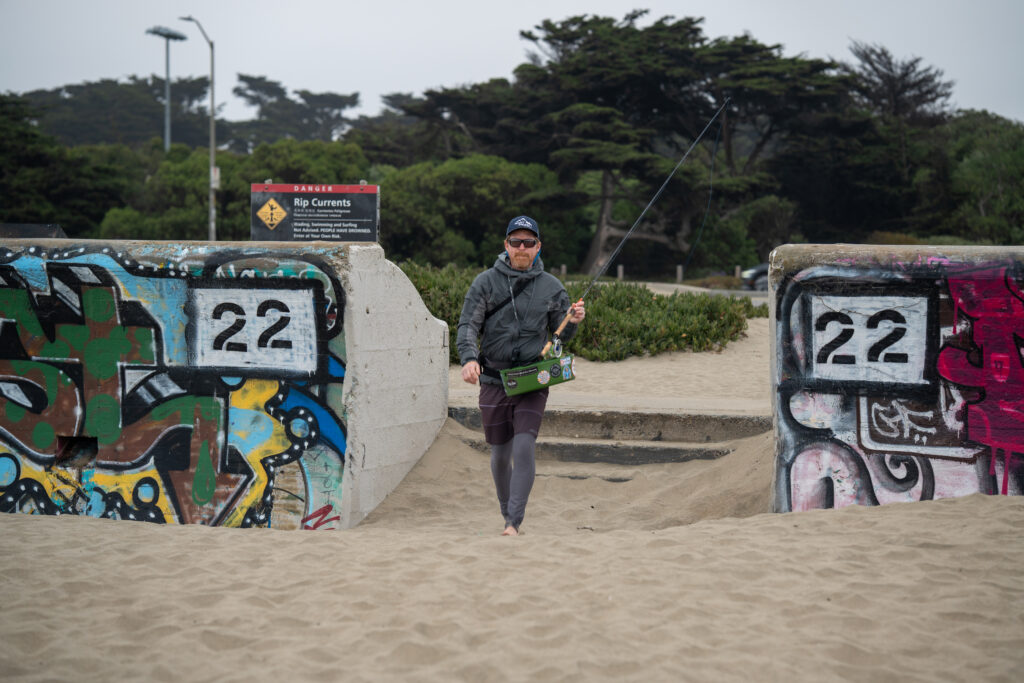
To make sense of these variables, there is no substitute for experience. My motto with fishing has always been, “There is only one way to find out, and that is to go.” Want to know what a 15-mile-per-hour wind from the north feels like at Stinson Beach? Go! Then you will know if you want to go again when you see it on the forecast. To learn the swell and tide, you don’t even need to fish to learn. Observe the conditions on the beach. When I was new to surf fishing, I found it helpful to jot down notes on when things went well or didn’t go well for future visits.
My first step when approaching the beach is to pause and observe from a point of elevation whenever possible. The structure on the beach is much more evident from high ground than when you are at water level. Reading the surf did not come easily, having grown up in the unidirectional world of trout streams. Look for dark water, calm spots, birds, and other anglers. Watch the waves crash, seeing where the waves form and break, indicating sandbars and shallower water, where the waves relax and indicate deeper water (what we want to fish.) Look for the tell-tale jiggle of deep water, whether trench or hole. Watch the white foam, noticing how it’s moving. Is there a persistent pattern like a rip current that funnels food to a specific zone? Look for spots that are as close to shore as possible. Surf fishing is about finding water you can fish, not water you wish to fish. Once you have identified a likely spot or spots, make a mental note of some landmarks (that won’t move), and walk down to the water. Now is a great time to take some time to stretch your line. The more time spent stretching you line the less your line will tangle when casting.
Once at the water’s edge, take a deep breath and smell the air. Open your arms and take in the power of the ocean. I recommend walking forward as the waves recede and back as they come at you. Establishing a rhythm with waves is critical when fishing the Pacific Ocean. A fly angler is a speck in something astonishingly vast. You need to figure out how to work with it, as working against it is a losing battle.
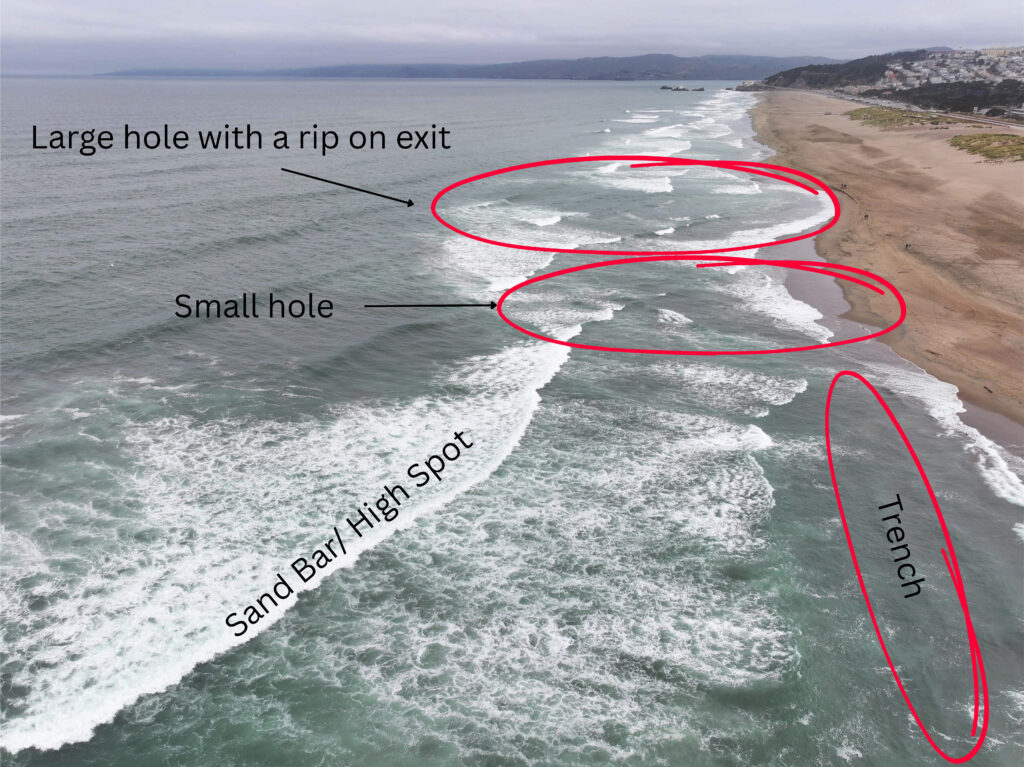
CASTING AND FISHING
Once you have developed a rhythm with your feet, look behind you for beachgoers or dogs to begin casting while advancing as the wave recedes. Your cast should be powerful and timed to land on the backside of the wave. Use false casts to time the wave. As soon as your fly lands, walk backward to keep your tension. Strip aggressively to target larger predator species and shorter shrimpy strips for perch. The goal is to stay tight to your fly so that when it gets smacked, you can strip set on the fish and prepare for a potentially legendary battle with a species you had not even fathomed of.
Fish hard and keep moving, cast all around the edges of the structure, and stay head-on. I like to think about where a fish may enter the deep water and where it may dead-end. The dead-end point may be where a fish lingers, looking for options. *SMACK* Keep calm, and don’t trout set. Strip hard to set the hook. Only then can you lift the rod and begin fighting the fish. After a heart-pounding battle with your sea creature, you must land the fish. Use the waves to push the fish toward you. Be careful to ease on pressure when the waves recede. Wait for a decent wave to push it up on the beach.
Smile! You have just done something extraordinary. You caught a fish on a fly rod in the Pacific Ocean with your feet in the sand.


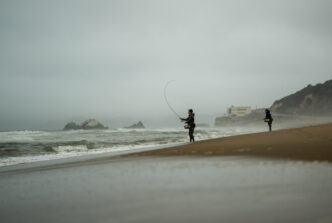
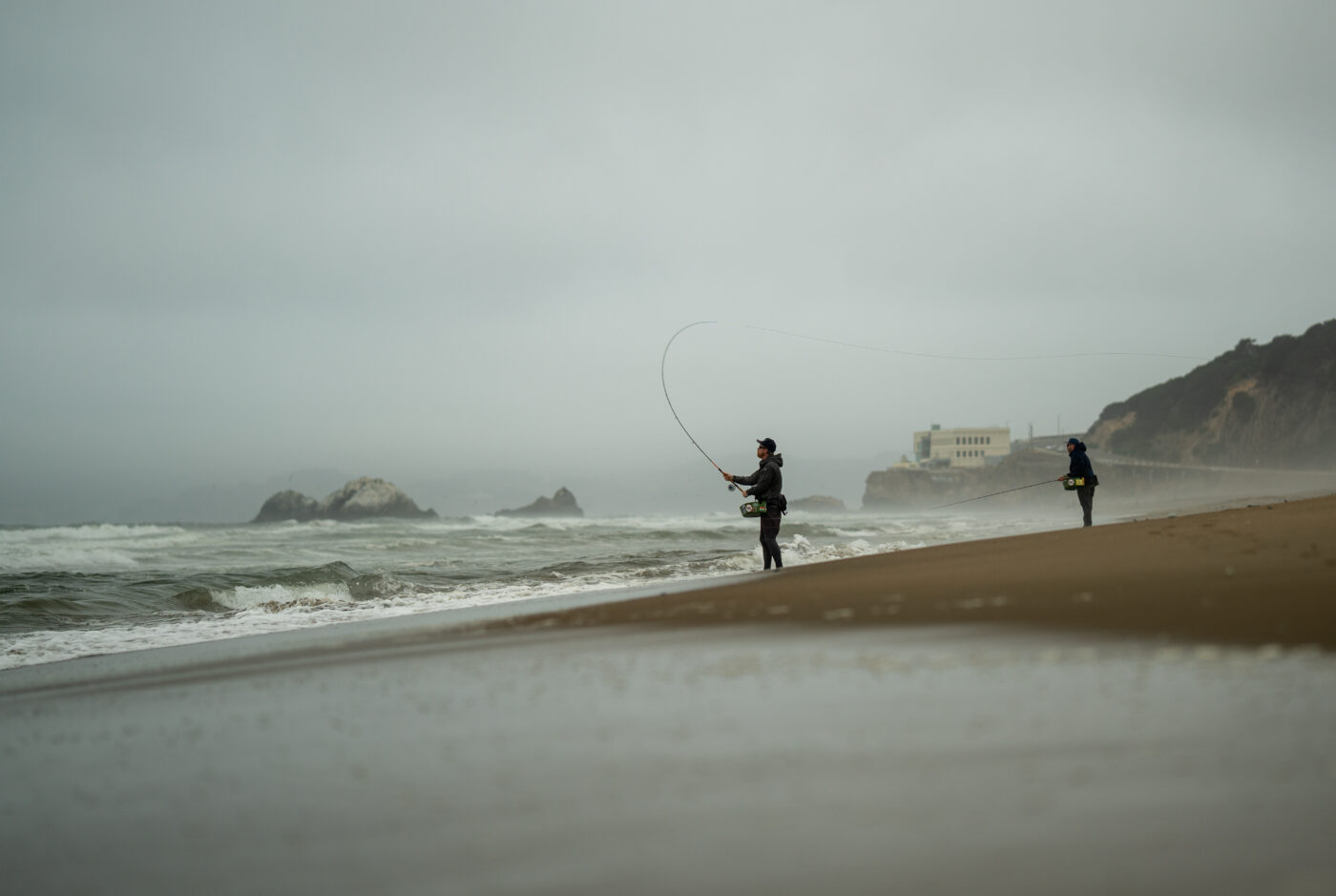


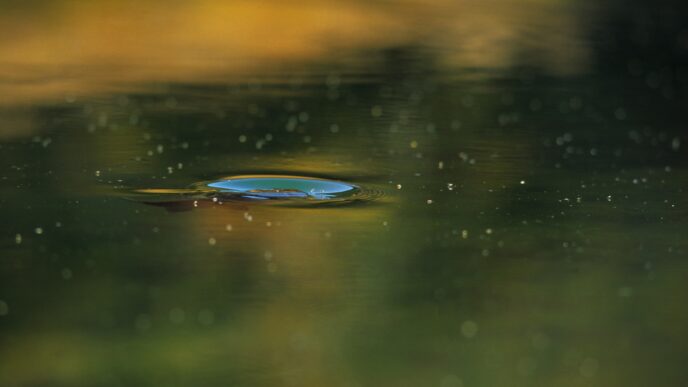
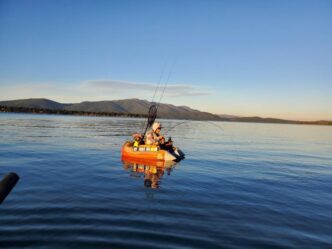
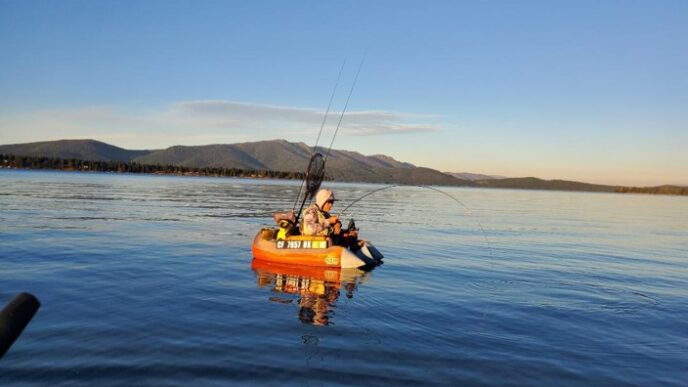
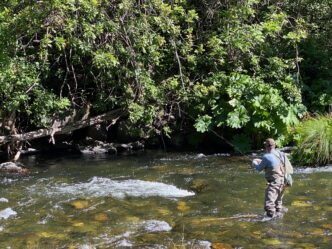
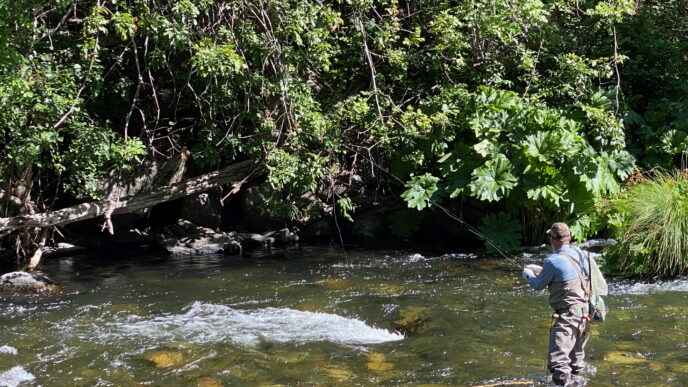
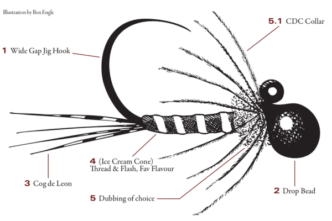
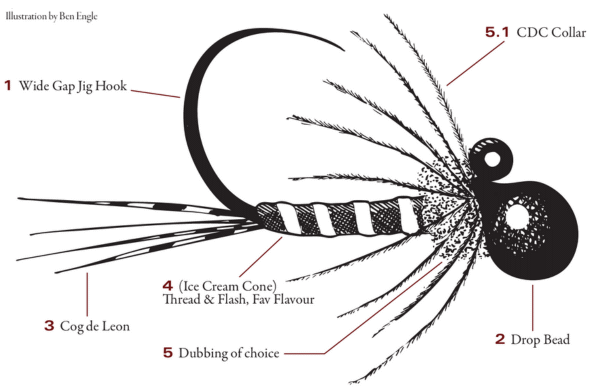
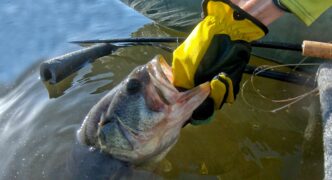
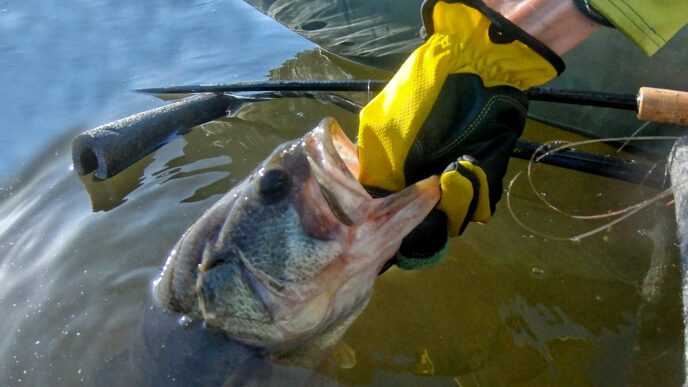
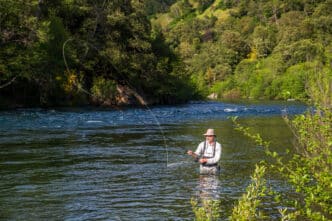
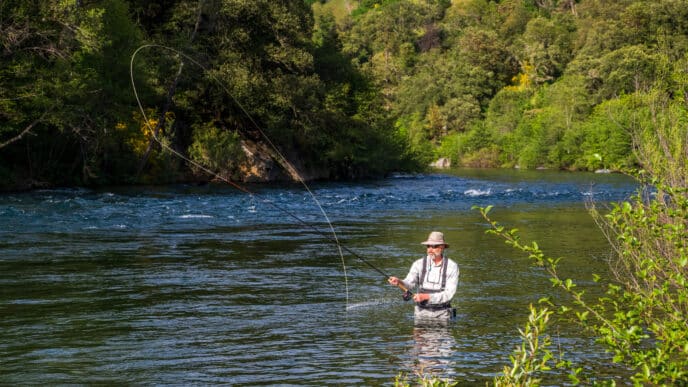
Great article on surf casting George. I am enjoying this new fly fishing activity, initially perch and sand bass in SoCal’s Newport Beach and Seal Beach respectfully. Initially found success off the breakwater at Loch Lomond marina, but need to focus on the beach locations. Love your encouragement. Thanks Martin